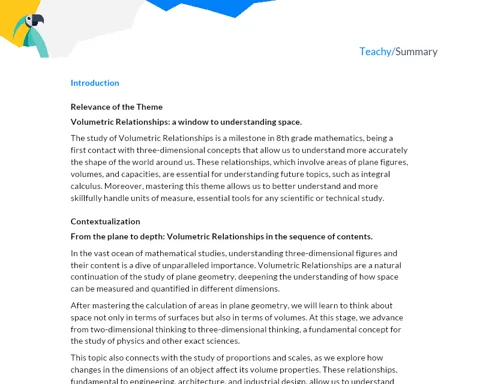Exploring Spatial Geometry: Unraveling the Surface Area of the Cylinder
Objectives
1. Calculate the lateral surface area of a cylinder.
2. Calculate the total surface area of a cylinder.
3. Solve practical problems involving the calculation of lateral and total areas of a cylinder.
Contextualization
Spatial geometry is a fascinating area of mathematics that helps us understand and calculate the three-dimensional shapes around us. Today, we will explore the cylinder, a shape we encounter in our daily lives in objects like soda cans, test tubes, and even architectural columns. Knowing how to calculate the surface area of a cylinder is essential for various practical activities, from engineering projects to product design.
Relevance of the Theme
Did you know that the formula for calculating the surface area of a cylinder is fundamental for various industries? For example, in civil engineering, it is crucial for calculating the materials needed to build pillars and columns. In the packaging industry, companies use this formula to determine the amount of material needed to manufacture cans and tubes. Additionally, product designers utilize these calculations to create efficient packaging that minimizes material waste.
Lateral Area of the Cylinder
The lateral area of a cylinder is the area of the curved surface that surrounds the cylinder. It can be visualized as a rectangle that is wrapped around the side of the cylinder. The formula for calculating the lateral area is given by 2πrh, where r is the radius of the base of the cylinder and h is the height.
-
Formula: 2πrh
-
Importance in engineering projects as material calculation
-
Essential for manufacturing cylindrical packaging
Area of the Bases of the Cylinder
The cylinder has two circular bases, each with an area of πr², where r is the radius of the base. The sum of the areas of these two bases makes up a significant part of the total area of the cylinder.
-
Formula: 2πr² (for both bases)
-
Application in volume calculations and container design
-
Relevant for determining the stability of cylindrical structures
Total Surface Area of the Cylinder
The total surface area of a cylinder is the sum of the lateral area and the areas of the two bases. The formula is 2πrh + 2πr². This calculation is fundamental for determining the total amount of material needed to cover the cylinder.
-
Formula: 2πrh + 2πr²
-
Crucial for cost estimates in engineering projects
-
Used in product design for material optimization
Practical Applications
- In civil engineering, calculating the total surface area of cylindrical columns helps determine the amount of concrete needed to cover them.
- In the packaging industry, calculating the surface area of soda cans allows for the optimization of material use and cost reduction.
- In product design projects, calculating the surface area of cylinders is essential for creating efficient and sustainable packaging.
Key Terms
-
Cylinder: A geometric solid with two parallel circular bases and a curved lateral surface.
-
Lateral Area: The area of the curved surface of a cylinder.
-
Total Surface Area: The sum of the lateral area and the areas of the two bases of a cylinder.
-
Radius (r): The distance from the center to the edge of a circular base of the cylinder.
-
Height (h): The distance between the two parallel bases of the cylinder.
Questions
-
How can calculating the surface area of a cylinder influence the efficiency of an engineering project?
-
In what ways can the application of these formulas help save material in industries that use cylinders?
-
What other three-dimensional shapes do you know that require surface area calculations for practical applications?
Conclusion
To Reflect
Throughout this lesson, we explored the importance of calculating the surface area of the cylinder, a fundamental skill not only in mathematics but in various professional fields. Understanding and applying these formulas allows us to solve real problems efficiently and effectively. From packaging production to engineering projects, mathematical knowledge is a powerful tool for optimizing resources and creating innovative solutions. Reflect on how this skill can be applied in different contexts and how it can contribute to your professional future.
Mini Challenge - Practical Challenge: Designing a Sustainable Package
Use the knowledge gained about the surface area of the cylinder to create a sustainable cylindrical package that minimizes material waste.
- Form groups of 3-4 students.
- Use cardboard to draw and cut out the components of the package: two circular bases and a rectangle for the lateral surface.
- Calculate the total surface area of the cylinder using the formulas learned in class.
- Assemble the cylindrical package using tape to join the parts.
- Present your package to the class, explaining how the mathematical calculations were applied to optimize material use.



